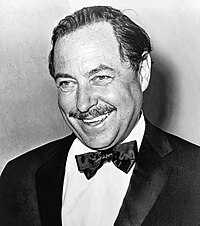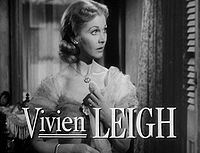Tennessee Williams
From Wikipedia, the free encyclopedia
| This article includes a list of references or external links, but its sources remain unclear because it has insufficient inline citations. Please help to improve this article by introducing more precise citations where appropriate. (August 2008) |
| Tennessee Williams | |||||||
|---|---|---|---|---|---|---|---|
 Williams in 1965. |
|||||||
|
|||||||
| Information | |||||||
| Period | 1930-1983 | ||||||
| Genre | Southern Gothic | ||||||
| Influences | Anton Chekhov D. H. Lawrence August Strindberg Hart Crane |
||||||
Tennessee Williams (born Thomas Lanier Williams, March 26, 1911 – February 25, 1983) was an American playwright who received many of the top theatrical awards. He moved to New Orleans in 1939 and changed his name to "Tennessee", the state of his father's birth.
He won the Pulitzer Prize for Drama for A Streetcar Named Desire in 1948 and for Cat on a Hot Tin Roof in 1955. In addition, The Glass Menagerie (1945) and The Night of the Iguana (1961) received New York Drama Critics' Circle Awards. His 1952 play The Rose Tattoo received the Tony Award for best play.
Contents |
[edit] Biography
Williams was born in Columbus, Mississippi, in the home of his maternal grandfather, the local Episcopal rector. He was of English descent. The home is now the Mississippi Welcome Center and tourist office for the city. Williams's middle name, Lanier, indicates his family's Virginia connections to the artistic family from England.
By the time Thomas was three, the family had moved to Clarksdale, Mississippi. At five, he was diagnosed with diphtheria. It caused his legs to be paralyzed for nearly two years but his mother encouraged him to make up stories and read. She gave him a typewriter when he was 11.[citation needed]
His father Cornelius Williams was a traveling salesman who became increasingly abusive as his children grew older. The father often favored Tennessee's brother Dakin, perhaps because of Tennessee's illness and extended weakness and convalescence as a child. Tennessee's mother Edwina Dakin Williams had aspirations as a genteel southern lady and was smothering. She may have had a mood disorder.
In 1918, when Williams was seven, the family moved again, this time to University City, Missouri, where he later attended University City High School.[1] In 1927, at 16, Williams won third prize (five dollars) for an essay published in Smart Set entitled, "Can a Good Wife Be a Good Sport?" A year later, he published "The Vengeance of Nitocris" in Weird Tales.
In the early 1930s Williams attended the University of Missouri, where he joined Alpha Tau Omega fraternity. His fraternity brothers dubbed him "Tennessee" for his rich southern drawl. In the late 1930s, Williams transferred to Washington University in St. Louis, Missouri for a year, and finally earned a degree from the University of Iowa in 1938. By then, Williams had written Cairo, Shanghai, Bombay!. This work was first performed in 1935 at 1780 Glenview in Memphis.
Tennessee Williams found inspiration in his problematic family for much of his writing.
Williams lived for a time in the French Quarter of New Orleans, Louisiana. He moved there in 1939 to write for the WPA. He first lived at 722 Toulouse Street, the setting of his 1977 play Vieux Carré. The building is part of The Historic New Orleans Collection. He began writing A Streetcar Named Desire (1947) while living at 632 St. Peter Street. He finished it later in Key West, Florida, where he moved in the 1940s.
Tennessee was close to his sister Rose, a slim beauty who was diagnosed with schizophrenia at a young age. As was common then, Rose was institutionalized and spent most of her adult life in mental hospitals. When therapies were unsuccessful, she showed more paranoid tendencies. In an effort to treat her, Rose's parents authorized a prefrontal lobotomy, a drastic treatment that was thought to help some mental patients who suffered extreme agitation. Performed in 1937 in Knoxville, Tennessee, the operation incapacitated Rose for the rest of her life.
Williams never forgave his parents. Her surgery may have contributed to his alcoholism and his dependence on various combinations of amphetamines and barbiturates often prescribed by Dr. Max (Feelgood) Jacobson.[2] They may have shared a genetic vulnerability, as Williams also suffered from depression.
Williams worked extremely briefly in the renowned Gotham Book Mart in Manhattan, lasting less than a day.
Williams' homosexual relationship with Frank Merlo, a second generation Sicilian American who had served in the U.S. Navy in World War II, lasted from 1947 until Merlo's death from cancer in 1963. With that stability, Williams created his most enduring works. Merlo provided balance to many of Williams' frequent bouts with depression[3] and the fear that, like his sister Rose, he would go insane.
[edit] Death
Williams died on February 24, 1983, after he choked on an eyedrop bottle cap in his room at the Hotel Elysee in New York. He would routinely place the cap in his mouth, lean back, and place his eyedrops in each eye.[4] The police report, however, suggested his use of drugs and alcohol contributed to his death. Many toxic drugs were found in the room. Williams' gag response may have been diminished by the effects of drugs and alcohol.
Williams' funeral took place on Saturday March 3, 1983 at St. Malachy's Roman Catholic Church in New York City. Williams' body was interred in the Calvary Cemetery, St. Louis, Missouri. Williams had long told his friends he wanted to be buried at sea at approximately the same place as the poet Hart Crane, as he considered Crane to be one of his most significant influences.
Williams left his literary rights to The University of the South in honor of his grandfather, Walter Dakin, an alumnus of the university. It is located in Sewanee, Tennessee. The funds support a creative writing program. When his sister Rose died after many years in a mental institution, she bequeathed over 50 million dollars from her part of the Williams estate to The University of the South as well.
In 1989, the University City Loop (in a suburb of St. Louis) inducted Tennessee Williams into its St. Louis Walk of Fame.
[edit] The work
The "mad heroine" theme that appeared in many of his plays seemed clearly influenced by the life of Williams' sister Rose.[citation needed]
Characters in his plays are often seen as representations of his family members. Laura Wingfield in The Glass Menagerie was understood to be modeled on Rose. Some biographers believed that the character of Blanche DuBois in A Streetcar Named Desire is also based on her, as well as Williams himself. When Williams wrote A Streetcar Named Desire, he believed he was going to die and that this play would be his swan song.[citation needed]
Amanda Wingfield in The Glass Menagerie was generally seen to represent Williams' mother. Characters such as Tom Wingfield in The Glass Menagerie and Sebastian in Suddenly, Last Summer were understood to represent Williams himself. In addition, he used a lobotomy operation as a motif in Suddenly, Last Summer.
Cat on a Hot Tin Roof and A Streetcar Named Desire both included references to elements of Williams' life such as homosexuality, mental instability and alcoholism.
Williams wrote The Parade, or Approaching the End of a Summer when he was 29 and worked on it through his life. It seemed an autobiographical depiction of an early romance in Provincetown, Massachusetts. This play was produced for the first time on October 1, 2006 in Provincetown by the Shakespeare on the Cape production company, as part of the First Annual Provincetown Tennessee Williams Festival.
The Parade, or Approaching the End of a Summer was among several works published by New Directions in the spring of 2008, edited and introduced by Williams scholar Annette J. Saddik. This collection of experimental plays was titled The Traveling Companion and Other Plays.
Williams' last play A House Not Meant to Stand is a gothic comedy published in 2008 by New Directions with a foreword by Gregory Mosher and an introduction by Thomas Keith. Williams called his last play a "Southern gothic spook sonata."
Other works by Williams include Camino Real and Sweet Bird of Youth.
[edit] Short stories by Tennessee Williams
- The Vengeance of Nitocris (1928)
- The Field of Blue Children (1939)
- The Resemblance Between a Violin Case and a Coffin (1951)
- Hard Candy: a Book of Stories (1954)
- Three Players of a Summer Game and Other Stories (1960)
- The Knightly Quest: a Novella and Four Short Stories (1966)
- One Arm and Other Stories (1967)
- Eight Mortal Ladies Possessed: a Book of Stories (1974)
- Tent Worms (1980)
- It Happened the day the Sun Rose, and Other Stories (1981)
[edit] One-Act Collections by Tennessee Williams
Tennessee Williams wrote over 70 one-act plays during his lifetime. The one-acts explored many of the same themes that dominated his longer works. Williams' major collections are published by New Directions in New York City.
- Dragon Country: a book of one-act plays
[edit] Collected works
- Gussow, Mel and Holditch, Kenneth, eds. Tennessee Williams, Plays 1937-1955 (Library of America, 2000) ISBN 978-1-88301186-4.
- Gussow, Mel and Holditch, Kenneth, eds. Tennessee Williams, Plays 1957-1980 (Library of America, 2000) ISBN 978-1-88301187-1.
[edit] See also
- Lanier family tree
- Virginia Spencer Carr, friend and biographer of Williams
[edit] Footnotes
- ^ Tennessee Williams and John Waters (2006) Memoirs, New Directions Publishing, 274 pages ISBN 0811216691
- ^ "The Kindess of Strangers", Spoto
- ^ Jeste ND, Palmer BW, Jeste DV. Tennessee Williams. Am J Geriatr Psychiatry. 2004 Jul-Aug;12(4):370-5. PMID: 15249274 [1]
- ^ Suzanne Daley (27.2.1983). Williams Choked on a Bottle Cap. The New York Times (engl.; abgerufen 27. Mai 2007)
[edit] References
| Wikimedia Commons has media related to: Tennessee Williams |
| Wikiquote has a collection of quotations related to: Tennessee Williams |
File:Tennessee Williams NYWTS.jpg
- Gross, Robert F., ed. Tennessee Williams: A Casebook. Routledge (2002). ISBN 0-8153-3174-6.
- Leverich, Lyle. Tom: The Unknown Tennessee Williams. W. W. Norton & Company; Reprint edition (1997). ISBN 0-393-31663-7.
- Saddik, Annette. The Politics of Reputation: The Critical Reception of Tennessee Williams' Later Plays (London: Associated University Presses, 1999).
- Spoto, Donald. The Kindness of Strangers: The Life of Tennessee Williams. Da Capo Press (Reprint, 1997). ISBN 0-306-80805-6.
- Williams, Tennessee. Memoirs. Doubleday (1975). ISBN 0-385-00573-3.
- Williams, Dakin. His Brother's Keeper: The Life and Murder of Tennessee Williams.
- Sewanee, The University of the South
[edit] External links
- Tennessee Williams at the Internet Movie Database
- Tennessee Williams at the Internet Broadway Database
- Tennessee Williams at the Internet off-Broadway Database
- New Directions Publishing Corporation
- Dramatists Play Service, Inc.
- Monologues by Tennessee Williams at Monologue Search
- A Streetcar Named Desire: Study Guide
- Portrait of Tennessee Williams by Margaret Holland Sargent
- Booksfactory article.
- A photograph of Tennessee Williams by Yousuf Karsh on the website of the National Gallery of Australia.
- Williams' Entry on the St. Louis Walk of Fame
- Tennessee Williams/New Orleans Literary Festival
- Tennessee Williams biography
- Berkeley Repertory Theatre: Suddenly Last Summer
- Interpreting Tennessee Williams - Working in the Theatre Seminar video at American Theatre Wing.org, April 2005
- American Experience on PBS. Tennessee Williams is featured in this documentary about New Orleans first aired February 12, 2007.
- Tennessee Williams Annual Review Journal published both electronically and in print by The Historic New Orleans Collection
- Tennessee and The Roman Muse: Tennessee Williams, his Time in Rome and his Friendship with Anna Magnani
- FamilySearch: Samuel Taylor Geer's Pedigree Resource File - Thomas Lanier "Tennessee" Williams
- Tennessee Williams Collection (MUM00482) owned by the University of Mississippi Department of Archives and Special Collections.
|
||||||||
|
||||||||



